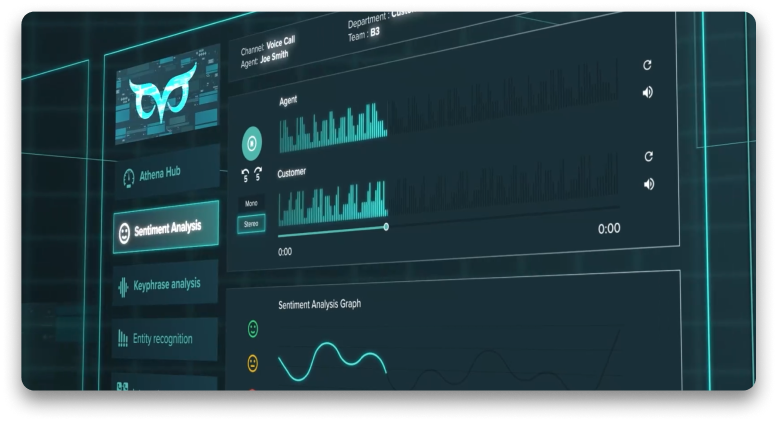Call Centre AI
Over the last couple of years, Artificial Intelligence has rightfully proven its potential to revolutionise the way companies do business across different industries. The customer engagement landscape has been particularly responsive to the innovations brought about by AI. Many Call Centre AI features have found massively beneficial applications in the customer engagement space, and particularly in the call centre landscape.
As we have suggested in this other article, Call Centre AI has the potential to change the way we understand customer service. But what exactly is Call Centre AI? How does it work? How will it change the customer service and call centre space in the years to come? What will that mean for human call centre agents?
We’ll try to address all those questions in this article. By the time you finish reading, you’ll have a more complete understanding of why Call Centre AI is showing itself as a game changer in the customer engagement landscape, what are the best ways to leverage it in your business, and what we can expect from its evolution. Let’s get to it.
What is Call Centre AI?
Call Centre Artificial Intelligence, or Call Centre AI, doesn’t refer to a single technology, but to a set of technologies: in general, we call Call Centre AI to any software or technology that uses Machine or Deep Learning, NLP (Natural Language Processing), ASR (Automatic Speech Recognition), probabilistic forecasting, or neural networks to fulfil tasks relevant to a Call Centres’ daily operations. In the following sections, we’ll see some more practical examples of what this looks like in the field.
However, these technologies are in constant evolution and expansion. Consequently, what Call Centre AI means or refers to rapidly changes with every new advance, and it will continue to change as new milestones are reached in the realm of Artificial Intelligence and more possible uses are found for AI in the customer engagement field.
As you probably already know, the evolution of Artificial Intelligence has progressed at an exponential rate over the past few years, and it’s only expected to continue to do so; and new Call Centre AI functionalities will continue to be established as AI experts in the CCaaS space continue to explore its full potential.
According to a recent survey by Deloitte, a substantial 79% of leaders in customer service have outlined plans to make significant investments in expanding their AI capabilities within the upcoming two years. This strategic shift underscores the growing recognition of AI’s immense potential to revolutionise customer engagement.
The realm of AI technology holds a wealth of possibilities for refining customer interactions, and its influence is poised to become increasingly prominent in shaping the dynamics of how businesses engage with their customer base.
This surge in AI adoption reflects a broader acknowledgment within the industry that leveraging advanced technologies is a must for optimising customer experiences and staying ahead in the competitive landscape.
In a further section, we’ll consider some of the most important and groundbreaking Call Centre Software AI tools, how they work, and what function they serve in the modern contact centre. But first, let’s see the multiple ways Call Centre AI tools are benefiting businesses in the customer engagement landscape.
How Call Centre AI Benefits Businesses
The impact represented by Call Centre AI in the customer engagement landscape, and the way this impact will prove even more significant in the coming years, cannot be overstated. A quick look at some statistics will suffice to prove how Call Centre AI, despite being still at its earliest stages, has already changed the customer engagement space in an irreversible way.
- By 2026, it is anticipated that automation will handle approximately 10% of agent interactions, marking a significant increase from the estimated 1.6% of interactions automated by AI in 2022 (Gartner).
- Approximately 60% of professionals in customer service acknowledge that AI has resulted in time savings for them (Dialpad).
- 65% of managers or higher-ranking leaders in organisations that integrate AI with human agents report that this approach has been highly effective in enhancing agent satisfaction (Forrester).
- Contact centres leveraging AI for customer service can handle over twice the number of calls compared to centres without AI integration (Dialpad).
- 83 percent of customer service representatives believe they can help more people with AI (Dialpad).
- 69% of leaders in organisations combining AI with human agents find the approach highly effective in significantly enhancing customer satisfaction through personalised experiences (Forrester).
- 59% of leaders in organisations combining AI with human agents find the approach highly effective in significantly boosting customer retention and lifetime value (Forrester).
As you can see, managers, business owners, and decision makers in the call centre space are already realising the potential of Call Centre AI, With this technology advancing in leaps and bounds, it’s only to be expected that the influence of AI in the modern call centre will grow even further in the coming years.
But what specific benefits can AI bring to the call centre? Let’s go through the main ones.
1. Improved employee engagement
There are several ways in which AI can improve employee engagement – and job satisfaction – across the call centre. With Forecasting functions, AI can identify peaks and troughs of call volumes, so you can forward plan how many agents are needed to meet service levels and reduce pressure. AI also identifies insights that help your teams resolve issues and upsell more efficiently, with tried-and-tested scripts, meaning more revenue.
2. A better understanding of customers
One of the most effective ways to improve the customer experience is to understand which talking points led to your desired outcome. Some Contact Centre AI tools can be an invaluable resource for that.
Using features such as Natural Language Processing (NLP) and speech analytics, customer service interactions can be recorded and transcribed for easy review. Transcriptions facilitate quick assessments by supervisors, enabling them to identify areas for agent coaching and pick up essential details. Other Call Centre AI tools, like Keyphrase Analysis and Entity Recognition aids in contact centre analytics, unveiling trends in large customer datasets and providing insights into customer emotions, enabling supervisors to adapt strategies for enhanced customer interaction and improved services.
Other Call Centre AI tools, notably Sentiment Analysis, stands out as a valuable tool for contact centres. Through an examination of factors like tone, vocabulary, speech rhythm, and inflection, Sentiment Analysis AI accurately assesses caller emotions, enabling contact centre managers to offer targeted coaching for enhanced customer service skills.
With customer data collected and analysed by AI at your fingertips, you can boost customer satisfaction and test the effectiveness of your campaigns.
As we’ve demonstrated, the best way to stay ahead of the competition is to provide top-notch customer experiences. AI can give your customers the right information at the right time, it can provide personalised recommendations, and it can analyse conversations at scale to help you provide improved first-call resolutions and handle calls faster.
AI can also help you master call deflection. Call deflection isn’t about reducing call volumes – although less pressure on your call centre is a benefit – it’s about strategically implementing it to enhance the customer experience. Successful call deflection is all about collecting and analysing the right data, to inform your strategy and increase customer satisfaction. It makes faster and better customer service possible, by enabling customers to skip the queue and make use of other channels.
4. Facilitate self-service and call deflection
AI can’t replace everything that a human agent can do, but it is often sufficient to reach a satisfactory resolution for simple requests. You can leave routine, day-to-day questions, and other fundamental interactions that might fall under the banner of “self-service” to AI. Help your callers complete simple tasks like placing an order, checking a balance, or paying a bill on their own, so your human agents are free to respond to more complex calls.
There is also a potential for AI to take on more significant self-service automations. This depends on having accurate data so that AI can correctly automate its responses to customers. Incomplete information limits the ability of AI to manage more complicated interactions. Prioritising data and analytics will be essential if you want AI to play a larger role in responding to customers and providing more significant degrees of self-service.
5. Cost Savings
The primary and often most appealing advantage of Call Centre AI, particularly for business owners and decision-makers, lies in cost reduction.
Employing technological solutions like Conversational AI chatbots allows businesses to address large volumes of routine queries automatically, allowing staff to focus on more complex, skill-demanding interactions. A study by Gartner reveals that Conversational Bots in contact centres will lower agent labour costs by $80 billion by 2026.
Call Centre AI Features
Conversational Bots
AI Conversational Bots are sometimes mistaken for traditional chatbots, and the term “chatbot” is often used interchangeably to refer to both tools; however, there is a significant difference between the two.
Chatbots are often rule-based, meaning they follow predefined scripts and can handle specific tasks or answer questions within the limits of their programming. AI Chatbots, on the other hand, display a much higher level of Artificial Intelligence and natural language understanding. These bots leverage advanced machine learning algorithms, including deep learning and neural networks, to comprehend and generate human-like responses. Unlike traditional chatbots that rely on rule-based systems, AI conversational bots can learn from interactions, adapt to user behaviour, and handle more complex conversations. They often excel in understanding context, recognizing user intent, and providing more personalised and dynamic responses.
While it is true that there is some scepticism around the real capabilities of chatbots, this all depends on the sophistication of the AI and Deep Learning algorithms under the hood of the chatbot in question A Study by Userlike reveals that 60% of individuals prefer interacting with a live agent over a chatbot, expressing concerns about the chatbot’s ability to accurately understand their queries. However, chatbots can also be extremely effective; according to a Gartner 2023 study, chatbots demonstrated a 52% resolution rate for customer queries related to orders and purchases, with a 48% rate for returns or cancellations. With Conversational AI still in its early stages, it is to be expected that these rates will experience a significant surge in the upcoming years.
In essence, Conversational AI can be a valuable tool when appropriately implemented, with AI sophistication powering a chatbot determines its responsiveness to standard queries, often outpacing human agents. The ideal chatbot complements staff by handling routine inquiries, allowing human agents to focus on high-value interactions that necessitate a human touch or specialised expertise.
ASR IVR
AI-powered Interactive Voice Response (IVR) systems leverage technologies like Automatic Speech Recognition (ASR) and Natural Language Processing (NLP) to comprehend customer queries and deliver precise information. These systems empower customers to engage with businesses through voice commands, eliminating the necessity for traditional menu-driven IVR systems.
With the integration of AI, IVRs intelligently direct calls to the most suitable department or agent, reducing wait times and elevating the overall customer experience. Moreover, AI-driven IVRs efficiently handle routine inquiries and execute basic tasks, such as bill payments or order tracking, without requiring human intervention.
This model of call centre automation optimises operational processes, allowing human agents to dedicate their expertise to more intricate and high-value interactions. The rapid, accurate, and personalised responses delivered by AI IVRs contribute significantly to heightened customer satisfaction, fostering increased loyalty and improved business outcomes.
Sentiment Analysis
Within the context of call centres, Sentiment Analysis stands out as a powerful application of speech analytics AI. By scrutinising elements like tone, vocabulary, speech rhythm, and inflection, AI can adeptly assess the emotional states of callers. This functionality enables AI to track the caller’s sentiments throughout a conversation, offering valuable insights into both the customer’s mood and the performance of the customer service agent.
Sentiment Analysis technology provides real-time data to customer service departments and contact centre managers, empowering them to gain a nuanced understanding of their teams’ performances. This valuable information facilitates targeted coaching sessions aimed at enhancing the customer service skills of agents, ultimately contributing to improved customer satisfaction and loyalty.
The ability to gauge sentiment aids in creating a more empathetic and responsive customer service environment, aligning with the goal of delivering exceptional customer experiences.
Speech analytics Call Centre AI tools offer multifaceted capabilities beyond Sentiment Analysis. Keyphrase analysis tools, for instance, meticulously track frequently used words and phrases during calls and text interactions. The resulting insights are compiled into comprehensive reports, providing managers and stakeholders in contact centres with valuable information. This analytical approach unveils customers’ priorities, enabling call centres and customer service departments to proactively anticipate market trends and maintain a competitive edge over industry rivals.
Moreover, Entity Recognition AI plays a pivotal role for customer service managers in identifying specific entities mentioned during calls, such as company names, brands, or products. This real-time detection allows businesses to promptly gauge the frequency of these mentions. The acquired data is instrumental in identifying the relevance of entities to the business and categorising them for future reporting. Through these advanced tools, Entity Recognition AI efficiently notes, categorises, and reports each instance an entity is referenced during customer service interactions, contributing to enhanced data-driven decision-making within call centres.
As you can see, there are multiple Call Centre AI functionalities with the potential to massively reduce man-hours dedicated to certain tasks, like call assessment, call routing, or the addressment of routine queries. However, this leads us to one question that we have hinted at before: where does the human component fit into all of this? Let’s consider it in the next section.
Will Call Centre AI replace the human agent?
As we have seen, multiple AI features can contribute to streamlining call centre operations, help agents fulfill their duties faster, and relieve them of menial tasks or routine interactions.
However, it’s crucial to remember something: at its core, customer service is all about human concerns and interactions. What call centre agents do best is assisting and tending to the individual on the other end of the line, ensuring they feel acknowledged and supported. In this context, the human element is indispensable and can’t easily be replaced with Call Centre AI.
AI faces several challenges in replicating human interactions, primarily in expressions of emotion, humor, and contemporary language usage. Despite advancements in AI technology, artificial intelligence often struggles to convey emotions effectively, resulting in delayed or unnatural responses that can disrupt the illusion of human interaction. Fake apologies, insincere compliments, and empty condolences generated by AI can be jarring and unconvincing to users.
Furthermore, the rapid evolution of language, including slang and cultural references, poses a significant obstacle for AI to keep up with the latest trends and nuances in human communication. While machines are continuously learning and improving, the complexity and fluidity of human interactions make the task of replicating them convincingly an ongoing challenge for AI developers.
If you enjoyed reading this, you might also be interested in…
Call Centre Software
Omnichannel Contact Centre
AI
Customer Service AI
Call Centre Phone System
AI and Automation
Customer Experience Automation



